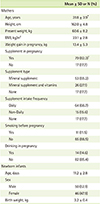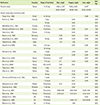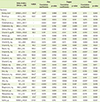1. Bernt KM, Walker WA. Human milk as a carrier of biochemical messages. Acta Paediatr Suppl. 1999; 88:27–41.

2. Winiarska-Mieczan A. Cadmium, lead, copper and zinc in breast milk in Poland. Biol Trace Elem Res. 2014; 157:36–44.

3. Al-Awadi FM, Srikumar TS. Trace-element status in milk and plasma of Kuwaiti and non-Kuwaiti lactating mothers. Nutrition. 2000; 16:1069–1073.

4. Donangelo CM, Trugo NM, Koury JC, Barreto Silva MI, Freitas LA, Feldheim W, Barth C. Iron, zinc, folate and vitamin B12 nutritional status and milk composition of low-income Brazilian mothers. Eur J Clin Nutr. 1989; 43:253–266.
5. Nagra SA. Longitudinal study in biochemical composition of human milk during first year of lactation. J Trop Pediatr. 1989; 35:126–128.

6. Lamounier JA, Danelluzzi JC, Vannucchi H. Zinc concentrations in human milk during lactation: a 6-month longitudinal study in southern Brazil. J Trop Pediatr. 1989; 35:31–34.

7. Rajalakshmi K, Srikantia SG. Copper, zinc, and magnesium content of breast milk of Indian women. Am J Clin Nutr. 1980; 33:664–669.

8. Rangan A, Jones A, Samman S. Zinc supplement use and contribution to zinc intake in Australian children. Public Health Nutr. 2015; 18:589–595.

9. Tan JC, Burns DL, Jones HR. Severe ataxia, myelopathy, and peripheral neuropathy due to acquired copper deficiency in a patient with history of gastrectomy. JPEN J Parenter Enteral Nutr. 2006; 30:446–450.

10. Larkin EC. Importance of fetal and neonatal iron: adequacy for normal development of central nervous system. Brain behaviour, and iron in the infant diet. London: Springer-Verlag;1990. p. 43–57.
11. Moser PB, Reynolds RD. Dietary zinc intake and zinc concentrations of plasma, erythrocytes, and breast milk in antepartum and postpartum lactating and nonlactating women: a longitudinal study. Am J Clin Nutr. 1983; 38:101–108.

12. Arnaud J, Favier A. Copper, iron, manganese and zinc contents in human colostrum and transitory milk of French women. Sci Total Environ. 1995; 159:9–15.

13. Leotsinidis M, Alexopoulos A, Kostopoulou-Farri E. Toxic and essential trace elements in human milk from Greek lactating women: association with dietary habits and other factors. Chemosphere. 2005; 61:238–247.

14. Iyengar GV. Reference values for the concentrations of As, Cd, Co, Cr, Cu, Fe, I, Hg, Mn, Mo, Ni, Pb, Se, and Zn in selected human tissues and body fluids. Biol Trace Elem Res. 1987; 12:263–295.

15. Ballard O, Morrow AL. Human milk composition: nutrients and bioactive factors. Pediatr Clin North Am. 2013; 60:49–74.
16. Ohtake M, Tamura T. Changes in zinc and copper concentrations in breast milk and blood of Japanese women during lactation. J Nutr Sci Vitaminol (Tokyo). 1993; 39:189–200.

17. Dörner K, Dziadzka S, Höhn A, Sievers E, Oldigs HD, Schulz-Lell G, Schaub J. Longitudinal manganese and copper balances in young infants and preterm infants fed on breast-milk and adapted cow's milk formulas. Br J Nutr. 1989; 61:559–572.

18. Lee JS, Lee YN, Kim ES. Study on Zinc and Copper Intakes of Breast-fed Infants. Korean J Nutr. 2000; 33:857–863.
19. Kwon MS, Yun IS, Cho MS, Lee HS, Kim WY. Effect of Maternal Factors on the Concentrations of Minerals and Immunological Substance in Breast Milk. Korean J Nutr. 2004; 37:809–816.
20. Sann L, Bienvenu F, Lahet C, Bienvenu J, Bethenod M. Comparison of the composition of breast milk from mothers of term and preterm infants. Acta Paediatr Scand. 1981; 70:115–116.

21. Mendelson RA, Anderson GH, Bryan MH. Zinc, copper and iron content of milk from mothers of preterm and full-term infants. Early Hum Dev. 1982; 6:145–151.

22. Casey CE, Neville MC, Hambidge KM. Studies in human lactation: secretion of zinc, copper, and manganese in human milk. Am J Clin Nutr. 1989; 49:773–785.

23. Parr RM, DeMaeyer EM, Iyengar VG, Byrne AR, Kirkbright GF, Schöch G, Niinistö L, Pineda O, Vis HL, Hofvander Y, Omololu A. Minor and trace elements in human milk from Guatemala, Hungary, Nigeria, Philippines, Sweden, and Zaire. Results from a WHO/IAEA joint project. Biol Trace Elem Res. 1991; 29:51–75.

24. Yoshinaga J, Li JZ, Suzuki T, Karita K, Abe M, Fujii H, Mishina J, Morita M. Trace elements in human transitory milk. Variation caused by biological attributes of mother and infant. Biol Trace Elem Res. 1991; 31:159–170.
25. Picciano MF, Guthrie HA. Copper, iron, and zinc contents of mature human milk. Am J Clin Nutr. 1976; 29:242–254.

26. Chierici R, Saccomandi D, Vigi V. Dietary supplements for the lactating mother: influence on the trace element content of milk. Acta Paediatr Suppl. 1999; 88:7–13.

27. Mello-Neto J, Rondó PH, Oshiiwa M, Morgano MA, Zacari CZ, dos Santos ML. Iron supplementation in pregnancy and breastfeeding and iron, copper and zinc status of lactating women from a human milk bank. J Trop Pediatr. 2013; 59:140–144.

28. Lönnerdal B. Effects of maternal dietary intake on human milk composition. J Nutr. 1986; 116:499–513.

29. Lönnerdal B. Trace element nutrition of infants--molecular approaches. J Trace Elem Med Biol. 2005; 19:3–6.
30. Meadows NJ, Grainger SL, Ruse W, Keeling PW, Thompson RP. Oral iron and the bioavailability of zinc. Br Med J (Clin Res Ed). 1983; 287:1013–1014.

31. Rossander-Hultén L, Brune M, Sandström B, Lönnerdal B, Hallberg L. Competitive inhibition of iron absorption by manganese and zinc in humans. Am J Clin Nutr. 1991; 54:152–156.

32. O'Brien KO, Zavaleta N, Caulfield LE, Wen J, Abrams SA. Prenatal iron supplements impair zinc absorption in pregnant Peruvian women. J Nutr. 2000; 130:2251–2255.
33. Fischer Walker C, Kordas K, Stoltzfus RJ, Black RE. Interactive effects of iron and zinc on biochemical and functional outcomes in supplementation trials. Am J Clin Nutr. 2005; 82:5–12.

34. Domellöf M. Iron requirements, absorption and metabolism in infancy and childhood. Curr Opin Clin Nutr Metab Care. 2007; 10:329–335.

35. Umapathy NS, Gnana-Prakasam JP, Martin PM, Mysona B, Dun Y, Smith SB, Ganapathy V, Prasad PD. Cloning and functional characterization of the proton-coupled electrogenic folate transporter and analysis of its expression in retinal cell types. Invest Ophthalmol Vis Sci. 2007; 48:5299–5305.

36. Andrews NC. The iron transporter DMT1. Int J Biochem Cell Biol. 1999; 31:991–994.

37. Frazer DM, Wilkins SJ, Becker EM, Murphy TL, Vulpe CD, McKie AT, Anderson GJ. A rapid decrease in the expression of DMT1 and Dcytb but not Ireg1 or hephaestin explains the mucosal block phenomenon of iron absorption. Gut. 2003; 52:340–346.

38. Lee J, Peña MM, Nose Y, Thiele DJ. Biochemical characterization of the human copper transporter Ctr1. J Biol Chem. 2002; 277:4380–4387.

39. Domellöf M, Lönnerdal B, Dewey KG, Cohen RJ, Hernell O. Iron, zinc, and copper concentrations in breast milk are independent of maternal mineral status. Am J Clin Nutr. 2004; 79:111–115.

40. Nikniaz L, Mahdavi R, Gargari BP, Gayem Magami SJ, Nikniaz Z. Maternal body mass index, dietary intake and socioeconomic status: differential effects on breast milk zinc, copper and iron content. Health Promot Perspect. 2011; 1:140–146.
41. Moser PB, Reynolds RD, Acharya S, Howard MP, Andon MB, Lewis SA. Copper, iron, zinc, and selenium dietary intake and status of Nepalese lactating women and their breast-fed infants. Am J Clin Nutr. 1988; 47:729–734.

42. Dhonukshe-Rutten RA, Vossenaar M, West CE, Schumann K, Bulux J, Solomons NW. Day-to-day variations in iron, zinc and copper in breast milk of Guatemalan mothers. J Pediatr Gastroenterol Nutr. 2005; 40:128–134.

43. Hannan MA, Faraji B, Tanguma J, Longoria N, Rodriguez RC. Maternal milk concentration of zinc, iron, selenium, and iodine and its relationship to dietary intakes. Biol Trace Elem Res. 2009; 127:6–15.

44. Vaughan LA, Weber CW, Kemberling SR. Longitudinal changes in the mineral content of human milk. Am J Clin Nutr. 1979; 32:2301–2306.

45. Vuori E, Mäkinen SM, Kara R, Kuitunen P. The effects of the dietary intakes of copper, iron, manganese, and zinc on the trace element content of human milk. Am J Clin Nutr. 1980; 33:227–231.

46. Finley DA, Lönnerdal B, Dewey KG, Grivetti LE. Inorganic constituents of breast milk from vegetarian and nonvegetarian women: relationships with each other and with organic constituents. J Nutr. 1985; 115:772–781.

47. Kirksey A, Ernst JA, Roepke JL, Tsai TL. Influence of mineral intake and use of oral contraceptives before pregnancy on the mineral content of human colostrum and of more mature milk. Am J Clin Nutr. 1979; 32:30–39.

48. Feeley RM, Eitenmiller RR, Jones JB Jr, Barnhart H. Copper, iron, and zinc contents of human milk at early stages of lactation. Am J Clin Nutr. 1983; 37:443–448.

49. Maru M, Birhanu T, Tessema DA. Calcium, magnesium, iron, zinc and copper, compositions of human milk from populations with cereal and 'enset' based diets. Ethiop J Health Sci. 2013; 23:90–97.
50. Trugo NM, et al. Concentration and distribution pattern of selected micronutrients in preterm and term milk from urban Brazilian mothers during early lactation. Eur J Clin Nutr. 1988; 42:497–507.
51. Friel JK, et al. Elemental composition of human milk from mothers of premature and full-term infants during the first 3 months of lactation. Biol Trace Elem Res. 1999; 67:225–247.

52. Tripathi RM, et al. Daily intake of heavy metals by infants through milk and milk products. Sci Total Environ. 1999; 227:229–235.

53. Aquilio E, et al. Trace element content in human milk during lactation of preterm newborns. Biol Trace Elem Res. 1996; 51:63–70.

54. Perrone L, et al. Interaction of trace elements in a longitudinal study of human milk from full-term and preterm mothers. Biol Trace Elem Res. 1994; 41:321–330.

55. Kim ES, Cho KH. Iron, Copper and Zinc Levels in Human Milk and Estimated Intake of the Minerals by Breast-Fed Infants during the Early Lactation. J East Asian Soc Diet Life. 2004; 14:27–33.
56. Yang Hye RK, Keum HK, Kime ES. A Study on the Contents of Selenium and Zinc in Human Milk. Korean J Nutr. 1995; 28:872–879.
57. Choi MG, et al. A Study on Iron, Zinc and Copper Contents in Human Milk and Trace Element Intakes of Breast-fed Infants. Korean J Nutr. 1991; 24:442–449.
58. Atinmo T, Omololu A. Trace element content of breastmilk from mothers of preterm infants in Nigeria. Early Hum Dev. 1982; 6:309–313.

59. Wasowicz W, et al. Selenium, zinc, and copper concentrations in the blood and milk of lactating women. Biol Trace Elem Res. 2001; 79:221–233.

60. Jirapinyo P, et al. Trace elements in Thai breast milk and infant formulas. J Trop Pediatr. 1985; 31:157–159.

61. Turan S, Determination of, et al. Determination of heavy metal contents in human colostrum samples by electrothermal atomic absorption spectrophotometry. J Trop Pediatr. 2001; 47:81–85.

62. Lemons JA, et al. Differences in the composition of preterm and term human milk during early lactation. Pediatr Res. 1982; 16:113–117.

63. Moran JR, et al. Concentrations and total daily output of micronutrients in breast milk of mothers delivering preterm: a longitudinal study. J Pediatr Gastroenterol Nutr. 1983; 2:629–634.











 PDF
PDF ePub
ePub Citation
Citation Print
Print



 XML Download
XML Download